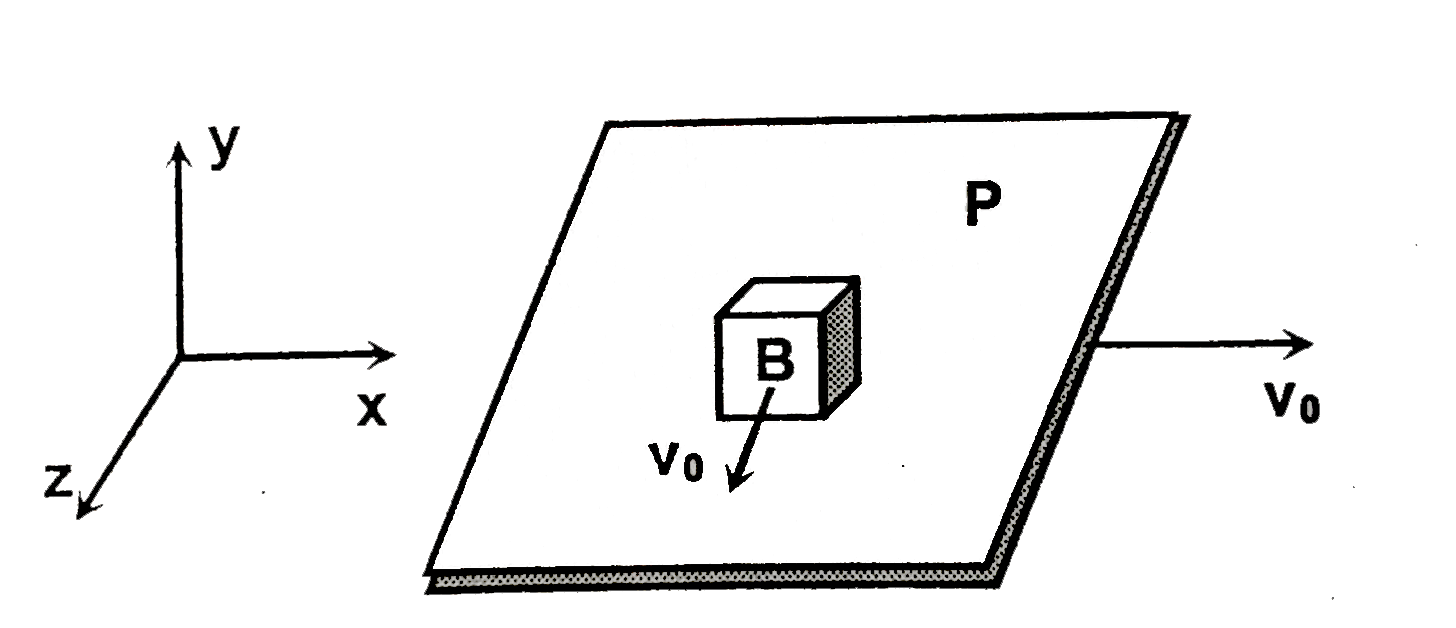In Fig. the velocities are in ground frame and the cylinder is performing pure rolling on the plank, velocity of point 'A' would be

2VC
2VC+VP
2VC+VP
2(VC−VP)
The correct Answer is:C
For pure rolling velocity of te point of contact as to be equal to the velocity of the surface.
Let us say cylinder rolls with angular velocity ω.
At point B,
VC−ωr=VP⇒ωr=VC−VP
At point A
VA=VC+ωr=2VC−VP

Topper's Solved these Questions
- RIGID BODY DYNAMICS 2BOOK - CENGAGE PHYSICSCHAPTER - RIGID BODY DYNAMICS 2EXERCISE - Multiple Correct
26 Videos
- RIGID BODY DYNAMICS 2BOOK - CENGAGE PHYSICSCHAPTER - RIGID BODY DYNAMICS 2EXERCISE - Linked Comprehension
71 Videos
- RIGID BODY DYNAMICS 2BOOK - CENGAGE PHYSICSCHAPTER - RIGID BODY DYNAMICS 2EXERCISE - Subjective
19 Videos
- RIGID BODY DYNAMICS 1BOOK - CENGAGE PHYSICSCHAPTER - RIGID BODY DYNAMICS 1EXERCISE - Integer
11 Videos
- SOUND WAVES AND DOPPLER EFFECTBOOK - CENGAGE PHYSICSCHAPTER - SOUND WAVES AND DOPPLER EFFECTEXERCISE - Integer
16 Videos
Similar Questions
In case of pure rolling, what will be the velocity of point A of the ring of radius R?

View SolutionIn the figure shown, a solid sphere of mass 'm' and radius r is released from a height 6r to slide down a smooth surface. A plank of same mass 'm' touches the horizontal portion of the surface at the ground. The co-efficient of friction between the plank and the sphere is μ and that between the plank and the ground is μ/4. Find the work done by the friction force between the plank and the ground till the sphere starts pure rolling on the plank. Neglect the height of the plank.

View Solution
Knowledge Check
In case of pure rolling what will be velocity of point A of the ring of radius R ?
 AVcmB√2VcmCVcm2D2Vcm
AVcmB√2VcmCVcm2D2VcmStatement-1: Friction is necessary for a body to roll purely on a level horizontal ground.
Statement-2: When the body is rolling purely, the velocity of the point of contact should be zero relative to the surface in contact.AStatement-1 is true, statement-2 is true and statement-2 is correct explanation for statement-1.BStatement-1 is true, statement-2 is true and statement-2 is NOT the correct explanation for statement-1.CStatement-1 is true, statement-2 is false.DStatement -1 is false, statement -2 is true.A very large plank P of some unknown mass is being moved with velocity v0ˆi under application of an external force (not shown in figure). Simultaneously a block B of mass m placed on the plank is also moving with velocity v0ˆk. All these velocities are with respect to ground frame and at t=0. Coefficient of frictioin between the plank and the block μ. Choose the correct option(s).
 AKinetic friction force acting on the block at t=0 is −μmgˆkBAt t=0, power developed (with respect to ground frame) by kinetic friction force on the block B is −μmgv0√2CAt t=0 power developed (with respect to ground frame) by kinetic friction force on the block B is −μmg√2v0DAt t=0, heat dissipation per sec in the system is 2√2μmgv0
AKinetic friction force acting on the block at t=0 is −μmgˆkBAt t=0, power developed (with respect to ground frame) by kinetic friction force on the block B is −μmgv0√2CAt t=0 power developed (with respect to ground frame) by kinetic friction force on the block B is −μmg√2v0DAt t=0, heat dissipation per sec in the system is 2√2μmgv0
Velocity Of A Point On Rolling Body
View SolutionWrite the nature of forces involved in the following cases.
A cylinder is rolling on the ground.
View SolutionIn which of the following cases it is certainly not possible for the diac to perform pure rolling.
View SolutionIf the velocity of centre of mass of a rolling body is V then velocity of highest point of that body is
View SolutionA ring of mass m having velocity v0 is placed on a long plank lies on smooth horizontal surface at time t=0 as shown. Find the time when the ring start pure rolling on the plank. [μ is coefficient of friction between the ring and the plank.]

View Solution
